Yeovil: Difference between revisions
No edit summary |
m ioe -> nhle, replaced: {{IoE|261341 → {{NHLE|1055713, {{IoE|261406 → {{NHLE|1056512, {{IoE|261407 → {{NHLE|1173463, {{IoE|261364 → {{NHLE|1296434 |
||
| (One intermediate revision by one other user not shown) | |||
| Line 15: | Line 15: | ||
|constituency=Yeovil | |constituency=Yeovil | ||
}} | }} | ||
'''Yeovil''' is a town in [[Somerset]]. It stands hard by the county's border with [[Dorset]], which is formed at that point by the [[River Yeo ( | '''Yeovil''' is a town in [[Somerset]]. It stands hard by the county's border with [[Dorset]], which is formed at that point by the [[River Yeo (Parrett)|River Yeo]]. Whether the river gives the town its name or the town the river is debated, but the Yeo in fact flows only around the edge of the town, not through its heart. | ||
The parish had a population of 27,949 at the 2001 census, though the wider urban area had a population of 42,140. Yeovil is not a pretty Someset town but a practical one. It has reinvented itself throughout the ages; once it was a centre for glove-making and n the 20th century it became a centre of the aircraft and defence industries, which made it a target for bombing in the Second World War. AgustaWestland, the helicopter company has been a large employer, but several other manufacturing and retail companies have bases in the town. | The parish had a population of 27,949 at the 2001 census, though the wider urban area had a population of 42,140. Yeovil is not a pretty Someset town but a practical one. It has reinvented itself throughout the ages; once it was a centre for glove-making and n the 20th century it became a centre of the aircraft and defence industries, which made it a target for bombing in the Second World War. AgustaWestland, the helicopter company has been a large employer, but several other manufacturing and retail companies have bases in the town. | ||
| Line 31: | Line 31: | ||
The name "Gifle" is believed to come from an Old Welsh word ''Gifl'' indicating a forked river.<ref>{{cite book|last=Mills|first=A.D.|title=A Dictionary of British Place-Names|publisher=Oxford University Press|location=Oxford|year=2003|isbn=978-0198527589}}</ref> | The name "Gifle" is believed to come from an Old Welsh word ''Gifl'' indicating a forked river.<ref>{{cite book|last=Mills|first=A.D.|title=A Dictionary of British Place-Names|publisher=Oxford University Press|location=Oxford|year=2003|isbn=978-0198527589}}</ref> | ||
It is quite possible then that "Yeovil" is derived from "Gifle" and that the name of the [[River Yeo | It is quite possible then that "Yeovil" is derived from "Gifle" and that the name of the [[River Yeo (Parrett)|River Yeo]] is a back-formation from this, as if the town were "Yeo-ville". Several other rivers in Somerset also bear the name of "[[River Yeo|Yeo]]" though, which in every other case is taken to come from the Old English ''ea'', meaning simply "river". | ||
[[Yeovilton]] lies on the same river but several miles downstream. Often taken to be named after Yeovil, it may instead be independently named from the river as ''Gifle-tun''. | [[Yeovilton]] lies on the same river but several miles downstream. Often taken to be named after Yeovil, it may instead be independently named from the river as ''Gifle-tun''. | ||
| Line 62: | Line 62: | ||
The Church of St John the Baptist dates from the late 14th century. The tower is 92 feet high, in four-stages with set back offset corner buttresses. It is capped by openwork balustrading eatching the parapets which are from the 19th century. There are two-light late-14th-century windows on all sides at bell-ringing and bell-chamber levels, the latter having fine pierced stonework grilles. There is a stair turret to the north-west corner, with a weather vane as a finial.<ref name="IoEstjohn"/> The tower contains two bells dating from 1728 and made by Thomas Bilbie of the Bilbie family in [[Chew Stoke]]. The "Great Bell" was recast from 4,502 lb to 4,992 lb.<ref>{{cite book | last=Moore | first=James | authorlink=| coauthors=Roy Rice & Ernest Hucker | title=Bilbie and the Chew Valley clock makers | year=1995 | publisher=The authors | location=| isbn=0952670208 }}</ref> | The Church of St John the Baptist dates from the late 14th century. The tower is 92 feet high, in four-stages with set back offset corner buttresses. It is capped by openwork balustrading eatching the parapets which are from the 19th century. There are two-light late-14th-century windows on all sides at bell-ringing and bell-chamber levels, the latter having fine pierced stonework grilles. There is a stair turret to the north-west corner, with a weather vane as a finial.<ref name="IoEstjohn"/> The tower contains two bells dating from 1728 and made by Thomas Bilbie of the Bilbie family in [[Chew Stoke]]. The "Great Bell" was recast from 4,502 lb to 4,992 lb.<ref>{{cite book | last=Moore | first=James | authorlink=| coauthors=Roy Rice & Ernest Hucker | title=Bilbie and the Chew Valley clock makers | year=1995 | publisher=The authors | location=| isbn=0952670208 }}</ref> | ||
The Church has been designated a Grade I listed building.<ref name="IoEstjohn">{{ | The Church has been designated a Grade I listed building.<ref name="IoEstjohn">{{NHLE|1055713|Church of St John The Baptist|accessdate=13 July 2007}}</ref> | ||
==History== | ==History== | ||
| Line 108: | Line 108: | ||
==Sights about the town== | ==Sights about the town== | ||
[[File:Barwick Follies, Jack the Treacle Eater - geograph.org.uk - 768926.jpg|right|thumb|200px|Jack the Treacle Eater, one of the Barwick follies]] | [[File:Barwick Follies, Jack the Treacle Eater - geograph.org.uk - 768926.jpg|right|thumb|200px|Jack the Treacle Eater, one of the Barwick follies]] | ||
One of the symbols of Yeovil is "Jack the Treacle Eater", a folly consisting of a small archway topped by a turret with a statue on top.<ref>{{cite web | title=Jack the Treacle Eater | work=Images of England | url=http://www.imagesofengland.org.uk/details/default.aspx?id=263573 | accessdate=2008-01-05}}</ref> This is actually located in the village of [[Barwick, Somerset|Barwick]], just to the south of the town. The hamstone Abbey Farm House was built around 1420 by John Stourton II, known as Jenkyn,<ref>{{ | One of the symbols of Yeovil is "Jack the Treacle Eater", a folly consisting of a small archway topped by a turret with a statue on top.<ref>{{cite web | title=Jack the Treacle Eater | work=Images of England | url=http://www.imagesofengland.org.uk/details/default.aspx?id=263573 | accessdate=2008-01-05}}</ref> This is actually located in the village of [[Barwick, Somerset|Barwick]], just to the south of the town. The hamstone Abbey Farm House was built around 1420 by John Stourton II, known as Jenkyn,<ref>{{NHLE|1056512|title=Abbey Farm House|accessdate=16 October 2008}}</ref> and the associated Abbey Barn dates from the same period.<ref>{{NHLE|1173463|title=Abbey Barn|accessdate=16 October 2008}}</ref> | ||
The Museum of South Somerset is in Hendford, and based in the former coach house to Hendford Manor. There are displays of local history and geology particularly local industries such as leather and glove-making, flax and hemp, stone working, engineering and newspaper printing.<ref>{{cite web|url=http://www.southsomersetmuseums.org.uk/|title=South Somerset Museum|publisher=South Somerset Museum|accessdate=21 March 2010}}</ref> The manor house itself was built around 1720 and has since been converted into offices. It is a Grade II* listed building.<ref>{{ | The Museum of South Somerset is in Hendford, and based in the former coach house to Hendford Manor. There are displays of local history and geology particularly local industries such as leather and glove-making, flax and hemp, stone working, engineering and newspaper printing.<ref>{{cite web|url=http://www.southsomersetmuseums.org.uk/|title=South Somerset Museum|publisher=South Somerset Museum|accessdate=21 March 2010}}</ref> The manor house itself was built around 1720 and has since been converted into offices. It is a Grade II* listed building.<ref>{{NHLE|1296434|title=Hendford Manor|accessdate=21 March 2010}}</ref> Newton Surmaville is a small park and house which is also known as Newton House. It was built between 1608 and 1612, for Robert Harbin, a Yeovil merchant. It has been designated a Grade I listed building.<ref>{{cite web|title=Newton Surmaville| work=Images of England|url=http://www.imagesofengland.org.uk/details/default.aspx?id=263579 | accessdate=25 September 2007}}</ref> | ||
==Cultural references== | ==Cultural references== | ||
Latest revision as of 11:20, 19 September 2019
| Yeovil | |
| Somerset | |
|---|---|
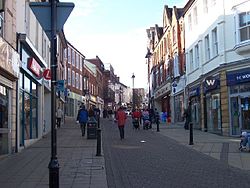 Middle Street, Yeovil | |
| Location | |
| Grid reference: | ST552164 |
| Location: | 50°56’43"N, 2°38’13"W |
| Data | |
| Population: | 27,949 (2002 est.) |
| Post town: | Yeovil |
| Postcode: | BA20, BA21, BA22 |
| Dialling code: | 01935 |
| Local Government | |
| Council: | South Somerset |
| Parliamentary constituency: |
Yeovil |
Yeovil is a town in Somerset. It stands hard by the county's border with Dorset, which is formed at that point by the River Yeo. Whether the river gives the town its name or the town the river is debated, but the Yeo in fact flows only around the edge of the town, not through its heart.
The parish had a population of 27,949 at the 2001 census, though the wider urban area had a population of 42,140. Yeovil is not a pretty Someset town but a practical one. It has reinvented itself throughout the ages; once it was a centre for glove-making and n the 20th century it became a centre of the aircraft and defence industries, which made it a target for bombing in the Second World War. AgustaWestland, the helicopter company has been a large employer, but several other manufacturing and retail companies have bases in the town.
The parish of Yeovil is part of the Stone Hundred.
Yeovil Country Park, which includes Ninesprings, is one of several open spaces in the town. It is well connected, on the A30 trunk road and the A37 and has two railway stations on two separate railway lines: Yeovil Pen Mill on the Bristol to Weymouth line and Yeovil Junction south of the town on the London Waterloo to Exeter line. (There is also a small railway museum in the town.) Yeovil has a range of educational, cultural and sporting facilities, and so it is a lively town.
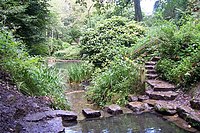
Ninesprings Country Park is in the south east near Penn Hill. It is linked to by a cycleway following the route of the old railway to Riverside Walk, Wyndham Hill and Summerhouse Hill forming the Yeovil Country Park.[1]
Name of the town
Yeovil was first mentioned in about 880 as Gifle (pronounced jivlə) and was recorded in the Domesday Book of 1086 as Givele. The river edging the town is today the named Yeo but also known as the "Ivel", which may have been Gifle in past days and given the town its name.
The name "Gifle" is believed to come from an Old Welsh word Gifl indicating a forked river.[2]
It is quite possible then that "Yeovil" is derived from "Gifle" and that the name of the River Yeo is a back-formation from this, as if the town were "Yeo-ville". Several other rivers in Somerset also bear the name of "Yeo" though, which in every other case is taken to come from the Old English ea, meaning simply "river".
Yeovilton lies on the same river but several miles downstream. Often taken to be named after Yeovil, it may instead be independently named from the river as Gifle-tun.
Churches
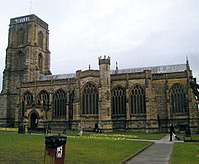
Churches include:
- Church of England:
- St John the Baptist (14th century)
- St Andrew's
- St James
- St Peter's
- St Michael's
- Holy Trinity
- Baptist: Yeovil Baptist Church
- Independent evangelical:
- Yeovil Community Church
- Yeovil Family Church
- The Mill Church
- Sunningdale Evangelical Church
- Methodist:
- Preston Road
- St Marks
- Vicarage Street
- Pentecostal (Elim)
- Salvation Army
- United Reformed Church
- Roman Catholic: Holy Ghost RC
The Church of St John the Baptist dates from the late 14th century. The tower is 92 feet high, in four-stages with set back offset corner buttresses. It is capped by openwork balustrading eatching the parapets which are from the 19th century. There are two-light late-14th-century windows on all sides at bell-ringing and bell-chamber levels, the latter having fine pierced stonework grilles. There is a stair turret to the north-west corner, with a weather vane as a finial.[3] The tower contains two bells dating from 1728 and made by Thomas Bilbie of the Bilbie family in Chew Stoke. The "Great Bell" was recast from 4,502 lb to 4,992 lb.[4]
The Church has been designated a Grade I listed building.[3]
History
Archaeological surveys have indicated signs of activity from the palaeolithic period, with burial and occupation sites located principally to the south of the modern town,[5] particularly in Hendford where a Bronze Age golden torc (twisted collar) was found.[6]
Yeovil was on the main Roman road from Dorchester to the Fosse Way at Ilchester. The route of the old road is aligned with the A37 from Dorchester, Hendford Hill, Rustywell, across the Westland site, to Larkhill Road, and Vagg Lane, rejoining the A37 at the Halfway House pub on the Ilchester Road. The Westland site has evidence of a small Roman town.[7] There were several Roman villas in the area, including finds at East Coker, West Coker and Lufton.[5]
Middle Ages
The town was recorded in the Domesday Book as Givele, a thriving market community.[8]
After the Norman Conquest the manor, later known as Hendford, was granted to the Count of Eu and his tenant Hugh Maltravers, whose descendants became Earls of Arundel and held the lordship until 1561.[6] In 1205 it was granted a charter by King John.[9] By the 14th century, the town had gained the right to elect a portreeve.[5]
The Black Death exacted a heavy toll, killing approximately half the population.[8] In 1499 a major fire broke out in the town, destroying many of the wooden, thatched roofed buildings.[10] Yeovil suffered further serious fires, in 1620 and again in 1643.[5]
Modern Period
After the dissolution of the monasteries the manor was held by the family of John Horsey of Clifton Maybank from 1538–1610 and then by the Phelps family until 1846 when it passed to the Harbins of Newton Surmaville.[6] The town was grievously ravaged by fires in 1620 and again in 1643.
Babylon Hill across the River Yeo to the south east of the town was the site of a minor skirmish, the Battle of Babylon Hill, during the English Civil War, which resulted in the Earl of Bedford's Roundheads forcing back Sir Ralph Hopton's Cavaliers to Sherborne.[6]
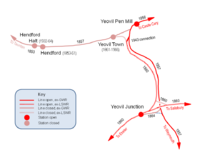
During the 1800s Yeovil was a centre of the glove making industry and the population expanded rapidly.[11] In the mid-19th century it became connected to the rest of Britain by a complex set of railway lines which resulted from competition between the broad gauge lines of the Great Western Railway (GWR) and the standard gauge lines of the London and South Western Railway (LSWR).
The first railway in the town was a branch line from the Bristol and Exeter Railway near Taunton to a terminus at Hendford on the western side of the town, which opened on 1 October 1853 (a GWR, broad gauge line), soon joined by Yeovil Pen Mill Station, and other lines followed: on 1 June 1861 passenger trains transferred to a new, more central, Yeovil Town station.[12][13]
In 1854, the town gained borough status and had its first mayor.[14]
In the early 20th century Yeovil had around 11,000 inhabitants and was dominated by the defence industry, making it a target of German raids during Second World War.[15] The worst of the bombing was in 1940 and continued until 1942. During that time 107 high explosive bombs fell on the town. 49 people died, 68 houses were totally destroyed and 2,377 damaged.[16]
Industrial businesses developed in the area around the Hendford railway goods station to such a degree that a small Hendford Halt was opened on 2 May 1932; but the Beeching Axe swung in 1964 and half of the town's stations closed. First to go was Hendford Halt which was closed on 15 June along with the line to Taunton, then Yeovil Town closed on 2 October 1964. Long-distance trains from Pen Mill]] had been withdrawn on 11 September 1961 leaving only Yeovil Junction with a service to London, but the service between there and Pen Mill, the two remaining stations, was also withdrawn from 5 May 1968.[12][13]
In April 2006 Yeovil became the first town in Britain to institute a somewhat controversial system of biometric fingerprint scanning in nightclubs. Individuals wishing to gain access to one of the town's nightclubs were asked in the first instance to submit their personal details for inclusion in a central system. This included a photograph and index fingerprint. Thereafter, each entry to one of the participating premises will require a fingerprint scan. If the system is proved successful at reducing crime and violence, it will be introduced in towns throughout the country.[17][18] In February 2007, Yeovil Town Council became the first English council to ban the children's craze Heelys in the centre of the town and High Street. Skateboards, roller skates and roller blades are also illegal in the area. Councillors have stated this is due to "numerous complaints about the activities of youngsters".[19]
Economy
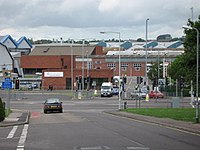
AgustaWestland builds helicopters in Yeovil,[20] and Normalair Garratt]], builder of aircraft oxygen systems, is also based in the town.[21]
Yeovil's reputation as a centre of the aircraft and defence industries lived on into the 21st century despite attempts at diversification, and the creation of numerous industrial estates, the principal employer is the aviation group AgustaWestland, created through the acquisition of Westland Helicopters by Agusta in 2000.[22]
In January 1986, the proposed sale of Westland to the American Sikorsky Aircraft group led to the Westland affair, a crisis in the Thatcher government, the resignation of Michael Heseltine as Secretary of State for Defence[23] and the resignation two weeks later of the of State for Trade and Industry, Leon Brittan, after his admission of leaking of a governmental law officer's letter which harshly criticised Mr Heseltine.[24]
Yeovil Aerodrome, sometimes known as Yeovil/Westland (to avoid confusion with nearby RNAS Yeovilton), is a mile west of the town centre. British defence giant BAE Systems also operate a site which produces high-integrity networked software solutions primarily for the military.
The Screwfix company is based in Houndstone having started life as the Woodscrew Supply Company in 1979.[25] However the warehouse was relocated to Stoke-on-Trent following failure to gain planning permission for building expansion.[26]
Sights about the town
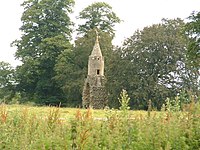
One of the symbols of Yeovil is "Jack the Treacle Eater", a folly consisting of a small archway topped by a turret with a statue on top.[27] This is actually located in the village of Barwick, just to the south of the town. The hamstone Abbey Farm House was built around 1420 by John Stourton II, known as Jenkyn,[28] and the associated Abbey Barn dates from the same period.[29]
The Museum of South Somerset is in Hendford, and based in the former coach house to Hendford Manor. There are displays of local history and geology particularly local industries such as leather and glove-making, flax and hemp, stone working, engineering and newspaper printing.[30] The manor house itself was built around 1720 and has since been converted into offices. It is a Grade II* listed building.[31] Newton Surmaville is a small park and house which is also known as Newton House. It was built between 1608 and 1612, for Robert Harbin, a Yeovil merchant. It has been designated a Grade I listed building.[32]
Cultural references
- Lifemanship:
- The Lifemanship books by Stephen Potter use Yeovil as the location for the School of Lifemanship, the series consisting of Gamesmanship (1947), Lifemanship (1950), One-Upmanship (1952), Supermanship (1958), Anti-Woo (1965) and The Complete Golf Gamesmanship (1968).
- School for Scoundrels (1960) was adapted from the Lifemanship books likewise used Yeovil though it was not filmed here
- One-Upmanship, a BBC Television comedy series (1974–78), starring Richard Briers and Peter Jones likewise had the reference.
- In Thomas Hardy's Wessex, Yeovil is known as "Ivell".[33]
- Wolf Solent a novel by John Cowper Powys (1929) has Yeovil as one of the three principal locations.
- The English Patient by Michael Ondaatje; the character of Maddox is cited as living in the nearby village Marston Magna.
Local band The Chesterfields released a single called "Last train to Yeovil" and the pop band Bubblegum Splash also released a song called "18:10 to Yeovil Junction".[34] The folk band Show Of Hands wrote a song entitled "Yeovil Town" about the violence and criminality they experienced after playing a small gig in Yeovil.[35]
References
- ↑ "Yeovil Country Park". Natural England. http://www.naturalengland.org.uk/ourwork/enjoying/places/countryparks/countryparksnetwork/findacountrypark/yeovil.aspx. Retrieved 22 March 2010.
- ↑ Mills, A.D. (2003). A Dictionary of British Place-Names. Oxford: Oxford University Press. ISBN 978-0198527589.
- ↑ 3.0 3.1 National Heritage List 1055713: Church of St John The Baptist
- ↑ Moore, James; Roy Rice & Ernest Hucker (1995). Bilbie and the Chew Valley clock makers. The authors. ISBN 0952670208.
- ↑ 5.0 5.1 5.2 5.3 Gathercole, Clare (2003). "An archaeological assessment of Yeovil". English Heritage Extensive Urban Survey. Somerset County Council. pp. 5–6. http://www1.somerset.gov.uk/archives/hes/downloads/EUS_YeovilText.pdf. Retrieved 1 February 2010.
- ↑ 6.0 6.1 6.2 6.3 Bush, Robin (1994). Somerset: The Complete Guide. Wimbourne: Dovecote Press. pp. 243–246. ISBN 978-1874336266.
- ↑ "Westland". Somerset Historic Environment Record. http://webapp1.somerset.gov.uk/her/details.asp?prn=15681. Retrieved 20 January 2008.
- ↑ 8.0 8.1 "Yeovil's History". Yeovil Town. http://www.yeoviltown.com/history.aspx. Retrieved 20 January 2008.
- ↑ Havinden, Michael (1981). The Somerset Landscape. The making of the English landscape. London: Hodder and Stoughton. pp. 113. ISBN 0340201169.
- ↑ Lewis, Samuel (1849). "Yeading — Yettington". A Topographical Dictionary of England. British History Online. http://www.british-history.ac.uk/report.aspx?compid=51437&strquery=Yeovil#s19. Retrieved 25 April 2010.
- ↑ "Political awareness". Yeovil Town Council. http://www.yeoviltown.com/history/political.aspx. Retrieved 23 March 2010.
- ↑ 12.0 12.1 Jackson, B.L. (2003). Yeovil, 150 Years of Railways. Usk: Oakwood Press. ISBN 0-85361-612-4.
- ↑ 13.0 13.1 Oakley, Mike (2006). Somerset Railway Stations. Bristol: Redcliffe Press. ISBN 1-904537-54-5.
- ↑ "Former mayors of Yeovil". Yeovil Town Council. http://www.yeoviltown.com/sites/YeovilTownCouncil/799.aspx. Retrieved 25 April 2010.
- ↑ "European Air War". Second World War Timelines. worldwar-2.net. http://www.worldwar-2.net/timelines/war-in-europe/european-air-war/european-air-war-index-1940.htm. Retrieved 25 April 2010.
- ↑ "Wartime". Yoevil Town Council. http://www.yeoviltown.com/history/wartime.aspx. Retrieved 23 March 2010.
- ↑ "BBC — Clubs to begin finger scan pilot". BBC News. 27 April 2006. http://news.bbc.co.uk/2/hi/uk_news/england/somerset/4951810.stm. Retrieved 6 April 2010.
- ↑ Morris, Steven (2 May 2006). "Guardian — Fingerprint scanners call time on yobs in Britain's Wild West". The Guardian (London). http://www.guardian.co.uk/uk/2006/may/01/ukcrime.prisonsandprobation. Retrieved 6 April 2010.
- ↑ Hilly town decides Heelys are just too dangerous, Daily Mail. Retrieved July 23, 2008
- ↑ "History". AgustaWestland. http://www.agustawestland.com/content/our-heritage-0. Retrieved 14 December 2007.
- ↑ "Honeywell Normalair-Garrett". Macrae's Blue Book UK. Owen Media Partners Inc.. http://www.macraesbluebook.co.uk/company/company.cfm?company=63610_Honeywell_Normalair-Garrett_Yeovil_Somerset. Retrieved 24 April 2010.
- ↑ "History". Augusta Westland. http://history.whl.co.uk/page4.html. Retrieved 24 April 2010.
- ↑ Peter Jenkins, Mrs Thatcher's Revolution: The Ending of the Socialist Era (Pan, 1989), p. 192.
- ↑ Leon Brittan to MT (24 January, 1986)
- ↑ "About Screwfix". Screwfix Ltd. http://www.screwfix.com/app/sfd/hlp/press_releases.jsp. Retrieved 24 April 2010.
- ↑ "Staff fix needed at DIY website". BBC News. 2004-09-27. http://news.bbc.co.uk/1/hi/business/3686404.stm. Retrieved 24 April 2010.
- ↑ "Jack the Treacle Eater". Images of England. http://www.imagesofengland.org.uk/details/default.aspx?id=263573. Retrieved 2008-01-05.
- ↑ National Heritage List 1056512: Yeovil
- ↑ National Heritage List 1173463: Yeovil
- ↑ "South Somerset Museum". South Somerset Museum. http://www.southsomersetmuseums.org.uk/. Retrieved 21 March 2010.
- ↑ National Heritage List 1296434: Yeovil
- ↑ "Newton Surmaville". Images of England. http://www.imagesofengland.org.uk/details/default.aspx?id=263579. Retrieved 25 September 2007.
- ↑ "Thomas Hardy's Wessex". University of St Andrews. http://www.st-andrews.ac.uk/~bp10/wessex/evolution/reviews/bookman1891.shtml. Retrieved 21 March 2010.
- ↑ "Chesterfields". Cherry Red Records. http://www.cherryred.co.uk/cherryred/artists/chesterfields.php. Retrieved 21 March 2010.
- ↑ "Show Of Hands Yeovil Town lyrics". Lyrics Mania. http://www.lyricsmania.com/yeovil_town_lyrics_show_of_hands.html. Retrieved 21 March 2010.
Outside links
| ("Wikimedia Commons" has material about Yeovil) |
